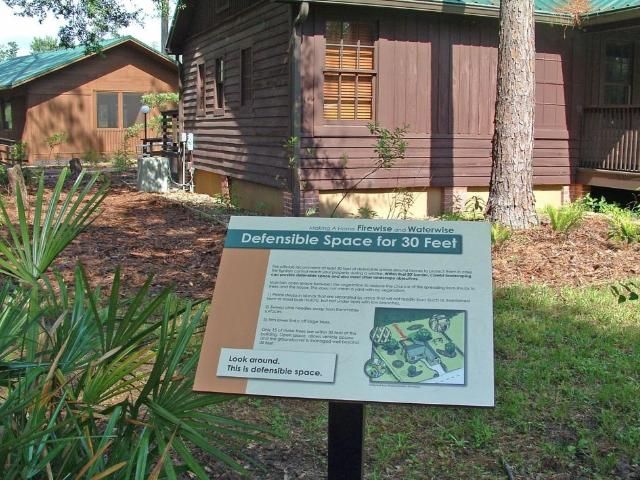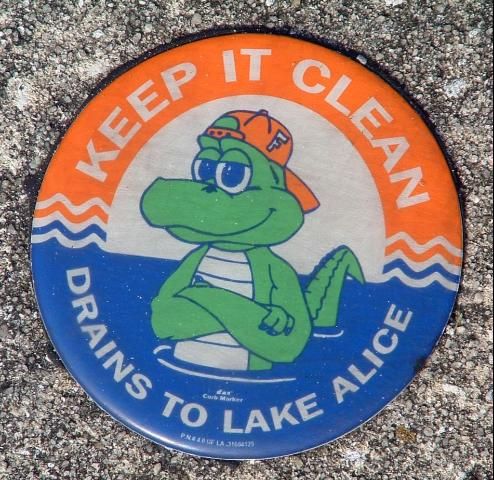Social marketing is used by many organizations and agencies to "sell" ideas. Frequently used to promote health behaviors, it has recently become popular among natural resource agencies and environmental organizations. The techniques are similar to those used to sell products, but in this case no money changes hands. Instead, we market an idea: improve water quality, protect endangered species, or explore nearby nature.
There are many opportunities for Extension agents and resource managers to use social marketing in the wildland-urban interface. The tools of social marketing are employed to encourage target audiences to accept a new idea and change their behaviors. These tools are most often used when the agency or organization has a clear mandate to protect the resource, when the issue is of great urgency, or when the target audience accepts the need to change but just has not done it. Many communities in Canada have developed a campaign to reduce vehicle idling called "Turn It Off" to improve air quality. Along the eastern U.S. coast, some marinas participate in a "Clean Marina" program that uses social marketing. The "Be Bear Aware" campaign in North America helps protect interface dwellers from black bears attracted to pet food, bird seed and garbage. In each case, the coordinating agency has a mandate to protect the resource and the audiences agree that this is a reasonable and important behavior to change.
There are situations where a persuasive message may aggravate conflict, too. When the community has not agreed upon the problem or the solution, an agency should use a different communication tool, such as a community forum.
Several EDIS publications provide additional information about wildland-urban interface issues, planning and land-use policy, management of fragmented forests, and communication strategies. This fact sheet focuses on social marketing strategies for promoting important messages and ideas in the interface.
The Process
The first step in developing a campaign is to select the specific behavior that should be changed (McKenzie-Mohr and Smith 1999). There could be a number of behaviors that resolve a problem; each should be analyzed and considered. Which is most appropriate for your office or agency to address? For which is there community support? Who would be the target audience for each? Is one easier to reach and change than another?
The second step is to select the audience and understand those individuals' attitudes toward the behavior. What are the barriers to accepting the new behavior? How strongly do people feel about the alternatives? A social marketing campaign could help change perceptions, or even remove obstacles and reduce barriers. Here are some examples of strategies that organizations and agencies are using.
- Busy people in the interface who commute long distances simply may not have the time needed to manage their landscapes. For them, devoting time on the weekend means giving up time with the family. Can you provide assistance or design a program that encourages all family members to participate? The Texas Forest Service developed a booklet that gives each family member a job to help create defensible space.
- Elderly people in the interface may not have the tools or skills to manage their landscapes. Behind the public library in Takoma Park, Maryland, is a "Tool Library," where residents can check out a ladder, a chain saw, and other equipment that they may not own.
- Commissioners up for re-election have different barriers than those who just won an election. Some will need to attract new voters while others need to satisfy existing voters. Can you make your issue a campaign concern? Civic organizations often sponsor candidate panels to enable residents to ask questions and hear from all candidates. This strategy could enable organizers to focus attention on their issues.
- Civic or youth groups who wish to do a service project in the interface will have a timeline, a budget, and a desire to make their activity more like fun than work. How can you engage and direct their energy? Having a sense of the opportunities available and the constraints that people face will help you develop programs that may overcome barriers.
You can find out what the barriers are by asking people who are doing the activity what accounts for their participation, and asking people who are not doing it what accounts for their lack of participation (Hernández 2000; McKenzie-Mohr and Smith 1999). Following are some of the typical responses:
- I don't know how.
- I don't know enough to know what to do.
- I don't have the resources.
- It isn't that important to me.
- You can't tell me what to do.
- I don't have the time.
- This is the way I've always done it.
- My neighbors aren't doing it.
Some of these barriers can be reduced by using good communication strategies. Procedural information can assist people who do not know how, background information can assist if people need to know more, and recognition of the values that are important to people may help them reconsider their decisions. The presenter's unspoken attitudes and the way he or she structures the presentation can affect how people respond. While an authority figure may generate the "you can't tell me" attitude, presenting helpful questions that invite people to figure out for themselves what to do may generate an "oh, I get it" response. But these techniques still do not address all the likely barriers. Social marketing practices offer some additional suggestions, such as those described here.
Use many desirable goals. You may find it helpful to design programs that achieve more than one goal and include goals that are not environmental (Jacobson et al., 2006). People commute by bicycles, for example, for health, fun, better parking options, and air quality concerns. Emphasizing only one reason to ride a bike is not as attractive. Athens, Georgia, sponsored a "Tour de Sprawl," an informative program to show residents the impacts of sprawl by bus and by bike. The tour was a way to communicate information, allow people to get exercise, and provide the sponsor some good publicity. Whatever the specific issue, protecting the health of the ecosystem is one good reason to practice beneficial behaviors in the interface. But people might be more motivated to do the right thing for other reasons: it looks better, their family has fun, or their risks are reduced. Use all the good reasons that are out there to support the ideal behaviors.
Use community leaders. Humans are social organisms. We care a great deal about what our neighbors are doing and how we fit into the community. It is difficult for some people to be the first in their group to do something different; they need the support of knowing that others are in agreement. Consequently, there is a great opportunity in working with the social fabric of a community to bring about change. Try producing advertisements that feature the mayor expressing support for the new behavior or that show a popular local minister engaged in the task. Newspaper articles that exemplify those who are conducting the new behavior (feature stories or news stories) can help readers understand that this is becoming a more common practice. You can also create community leaders by recognizing neighborhood champions who promote your mission.
Make learning social. Group activities, neighborhood gatherings, family festivals, and workshops are other strategies that are helpful to communicate information and increase the attractiveness of a new behavior. Neighborhood workdays have been used in Texas, Colorado, and Oregon to reduce wildfire risk by removing vegetation near homes and in North Carolina to maintain community hiking trails. The Florida Black Bear Festival in Umatilla, Florida, is an opportunity to tell residents how to avoid attracting bears to their bird feeders and garbage cans. Workshops have been used in various places to deliver information about skills and increase confidence. Extension agents offer programs to teach how to Xeriscape yards, attract wildlife, and manage hunting leases. Giving neighbors the opportunity to embark on the learning process together helps reduce their fear of the unknown and build camaraderie. It also develops a support system if someone has a question later on: a neighbor may remember the answer.
Model it. If people are unfamiliar with the task, you can develop a demonstration site that shows how to do it and how it will look when it is complete (procedural and consequential information). Extension agents use demonstration areas to show composting bins, gardening techniques, mulch options, and even land managed with prescribed fire. A neighborhood demonstration area will not only indicate how the change will look but will also imply that the new look is appropriate right there (Figure 1). By driving past every day, residents will become more accustomed to the new look. A single effort can be magnified if it is well placed and is accompanied by informational signs or brochures. Such actions can help overcome the "my neighbors are not doing it" barrier. Information accompanying a demonstration or model could include detailed information on how to build your own and what types of benefits you can expect to see.

Credit: M. Monroe
Provide a prompt. Sometimes people know what to do, intend to do it, but just forget (Figure 2). In other cases, people want to buy the right product, but neglect to do the research to find out—for instance, which plants are native or which pesticides are target specific. Resource agencies and retailers can develop prompts that remind people what to do or buy when they are ready. Informational tags on the plants at local nurseries can provide the facts people need for choosing the right plants for fire-prone interface areas. The Florida Fish and Wildlife Conservation Commission produces refrigerator magnets to remind interface dwellers to put their garbage out on garbage day and not before, to reduce problems with black bears.

Credit: M. Monroe
Ask for commitment. Research shows that people are more likely to do something if they voluntarily agree to do so. Putting that commitment in writing is even more effective than a spoken promise. It may be possible for agents or resource professionals to obtain either spoken or written commitment when they have personal contact with the public, whether at an information booth, at a workshop, or on a door-to-door campaign. The conversation must include information about the problem and the solution. If the audience is receptive and interested, the resource professional can ask a simple and non-offensive question, such as "Can I call you in a few weeks to see if you have any questions about your new rain gauge?" or "Would you sign this form to allow us to use your name in a newspaper advertisement that will showcase people who are reducing water use?"
Summary
Social marketing tools can be powerful techniques for conveying messages that promote behavior changes. When agencies choose to use these techniques, there is often a clear legislative mandate to promote certain behaviors and the community acknowledges this is the appropriate course of action.
Suggested Readings
Fostering Sustainable Behavior: An Introduction to Community-Based Social Marketing by Douglas McKenzie-Mohr and William Smith, 1999. Gabriola Island, British Columbia: New Society Publishers. An accompanying website, http://www.cbsm.com hosts a large number of cases, reports and articles.
References
Hernández, O. 2000. "Formative Research." Environmental Education and Communication for a Sustainable World. Eds. B. A. Day and M. C. Monroe, 47-56. Washington DC: Academy for Educational Development.
Jacobson, S., M. McDuff, and M. C. Monroe. 2006. Conservation Education and Outreach Techniques. Oxford UK: Oxford University Press.
McKenzie-Mohr, D. and W. Smith. 1999. Fostering Sustainable Behavior: An Introduction to Community-Based Social Marketing. Gabriola Island BC: New Society Publishers.